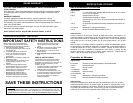
7
STIRRING FOOD
Little or no stirring is required when using
the low or keep warm setting. When using
the high setting, stirring ensures even
flavor distribution.
Heat
Setting
Low High
3-4 Lb.
Chicken
6-8 Hours 3-4 Hours
3-4 Lb. Pot
Roast
6-8 Hours 4-5 Hours
3 Qt. Beef
Stew
8-10 Hours 4-5 Hours
3 Qt. Chili 8-10 Hours 4-5 Hours
3 Qt.
Vegetable
Soup
6-8 Hours 3-4 Hours
The cooking times given above should be
used ONLY
as a guide. It is recommended
that a food thermometer be used to check
the temperature to ensure the food is
completely cooked.
BASIC COOKING TIME GUIDE
•
The cover of the slow cooker does not
form a tight fit on the ceramic pot but
should be centered on the ceramic pot
for best results. Do not remove the
glass cover unnecessarily - this will
result in major heat loss. Do not cook
without the glass cover in place.
• Stirring is not normally needed when
using a slow cooker. However, if
cooking on high, you may want to stir
occasionally.
• Slow cooking retains most of the
moisture in foods. If a recipe results
in too much liquid at the end of the
cooking time, remove glass cover,
turn the control knob to high, and
reduce the liquid by simmering. This
will take 30-45 minutes.
• The slow cooker should be at least
half-filled for best results.
• If cooking soups or stews, leave a
2-inch space between the top of the
ceramic pot and the food so that the
food may be allowed to simmer.
DO
• Handle the ceramic pot and glass lid
with care.
• Use oven mitts when lifting the
ceramic pot containing hot foods.
• Avoid extreme temperature changes
in the ceramic pot or glass lid. For
example, do not place into or under
cold water while still hot.
DO NOT
• Use the ceramic pot if chipped or
cracked.
• Operate the slow cooker without the
ceramic pot in place.
• Place the hot ceramic pot onto a wet
surface.
• Use frozen meats or foods in slow
cooker. Always defrost them first.
• Place the glass lid in oven or
microwave.
NEVER
• Use abrasive cleansers or metal
scouring pads when cleaning the
ceramic pot.
• Place water or other liquids into the
metal housing of the slow cooker.
• Immerse the metal housing, cord or
plug of the slow cooker into water or
any other liquid.
• Touch hot surfaces with bare hands.
TIPS FOR SLOW COOKING
• Many recipes call for cooking all day.
You can also prepare the recipe the
night before by placing all ingredients
in the ceramic pot, cover and
refrigerate overnight. In the morning,
simply place the ceramic pot in the
slow cooker and select the time and
temperature setting.
• Meat & Poultry require at least 7 to 8
hours on LOW. Do not use frozen
meat in the slow cooker. Thaw any
meat or poultry before slow cooking.
• Trim all visible fat from meat or
poultry.
• Cook dried beans 1-2 hours on high
setting, then add remaining
ingredients, cook on low for the
remaining time.
• When cooking curries and casseroles,
richer, more intensive flavors will
develop when the first stage is
prepared by traditional methods, i.e.
brown the onions, meat and spices
first in a non-stick pan.
TIPS FOR SLOW COOKING (cont)
23
CUIDADO: Asegurarse que la
unidad esté desconectada del
tomacorriente y apagada con el botón
en “Off” antes de limpiarla.
• Siempre dejar que la unidad se
enfríe antes de limpiarla o lavarla.
• Sacar el tazón de cerámica y la tapa
de vidrio y lavarlas en agua caliente
jabonosa usando un detergente para
lavadora de vajillas. Enjuagar y
secar bien.
• Nunca usar limpiadores abrasivos ni
almohadillas de metal para limpiar el
tazón de cerámica ni la tapa de
vidrio.
• Para ablandar los residuos rebeldes
de alimentos que se han cocinado,
llenar el tazón de cerámica con agua
jabonosa tibia y dejar que se
remojen. Después sacarlos frotando
con una escobilla de nylon para
cocina.
• El tazón de cerámica y la tapa de
vidrio pueden lavarse en el
lavavajillas. Sin embargo, se debe
tener cuidado de no despostillar ni
rajar el tazón de cerámica ni la tapa
de vidrio.
• Nunca sumergir el casco metálico, el
cordón ni el enchufe en agua ni otro
líquido.
• Limpiar el casco metálico
únicamente con un paño
humedecido. NO sumergir en agua.
• Al guardar la olla cocción lenta,
enrollar el cordón en forma suelta,
pero no alrededor de la olla.
OPERATING INSTRUCTIONS (CONT.)
LIMPIEZA Y MANTENIMIENTO


















